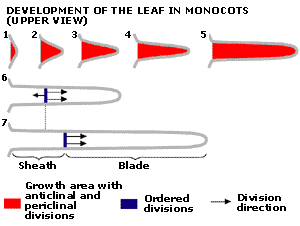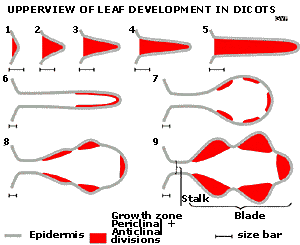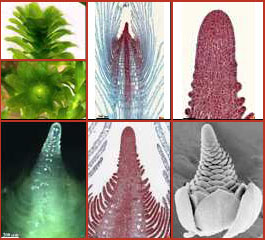Leaves are structures which are derived from stems. The
initial stages of leaf formation are the same for monocots and dicots. Variations in morphogenesis between the shoots of
monocot and
dicot plants occur at a later stage.
Initial leaf formation begins immediately behind the top meristem (1) with periclinal divisions (with the division plane parallel to the surface; red in figure 2) in the subepidermal celllayers and soon later in the epidermis. After the first divisions also anticlinal (at right angles to the surface; blue in figure 2) divisions occur. The result is a small bulge (3) that will further develop into a leaf.
From this point on, leaf growth differs between
monocots and
dicots.
| LEAF INITIATION |
| MONOCOTS | DICOTS |

|

|

|

|
|
In monocots the initial bulge further elongates by mitotic cell divisions until a certain size is reached (1-4). Then, overal cell division stops (5). Only cells in a small region at the base of the leaf further divide (6), i.e. nearly exclusively in parallel to the leaf base. This is how the typical longitudinal arrays of epidermal cells and the parallel venation of monocot leaves arise. Below this division zone a sheath is formed that surrounds the stem. A leaf stalk is absent. The opposite side develops into the leaf blade. Leaf growth may continue without limitation as long as this meristem exists (7). As a result, grasses can resume growth after mowing or grazing. This behavior is common to all monocots, also to the aquatic plants belonging to this group, like Elodea canadensis shown below.
|
In dicots, the initially formed bulge further elongates by mitotic cell divisions throughout the bulge (1-5). Then, at the top of the extended bulge, cells start to divide a single plane causing the sheath to broaden (6). Depending on the species, division activity concentrates on certain regions (7-9) leading to the typical shape of some dicot leaf blades, e.g. serrate of lobbed. The lower part of the extended bulge develops into the leaf stalk or petiole (9).
Hoe deze ontwikkeling op cel- en weefselnivo verloopt, is bij de plaatjes van de siernetel hieronder te zien[/ned]The images here below depict how this development occurs at the cell and tissue level in Coleus.
|
| Example: Elodea (Elodea canadensis) |
Example: Coleus |
|

|
|
| Click on the thumbnails to be redirected to detailed views of the growth cone of elodea | Click on the thumbnails to be redirected to detailed views of the growth cone of coleus |







